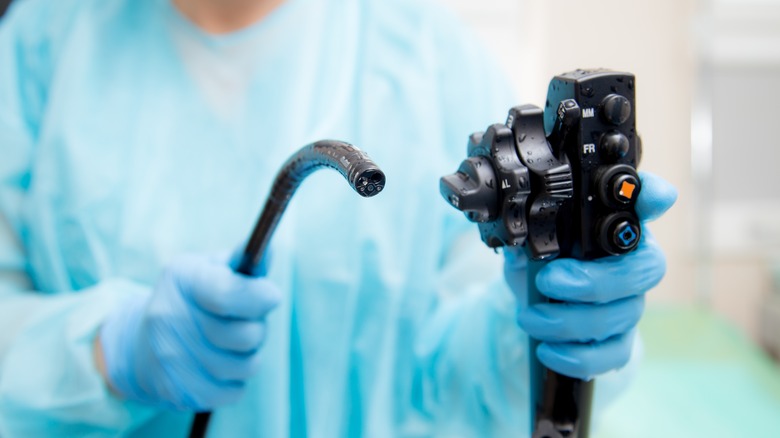How Are You Diagnosed With Crohn's Disease?
An estimated 3 million Ameicans are currently living with inflammatory bowel disease (IBD) – a blanket term used to describe a number of conditions that cause chronic inflammation in the digestive tract (per Centers for Disease Control and Prevention (CDC)). Ulcerative colitis and Crohn's disease are the two most common forms of IBD, with the latter affecting more than half a million people in the United States.
Crohn's disease typically causes inflammation in the small intestine, but can also affect other parts of the digestive tract — especially if left untreated (per Mayo Clinic). Abdominal pain, chronic diarrhea, weight loss, reduced appetite, and rectal bleeding are common symptoms associated with Crohn's disease. Most people with the condition will experience flare-ups of these symptoms. These are followed by periods of remission where symptoms seem to dissipate or disappear — at least for a little a while
More than just an upset stomach, Crohn's disease can be downright debilitating with the potential to cause real, life-threatening complications. For that reason, diagnosis and treatment are essential. However, diagnosing Crohn's disease can be a little challenging.
Physical exam and lab testing
Without a singular diagnostic test to identify Crohn's disease, doctors often have to rule out other conditions that may be causing your symptoms. The first step to receiving a Crohn's diagnosis is setting up an appointment for a physical exam with your healthcare provider. During the exam, your doctor will likely inspect your abdomen. They will check for bloating, listen with a stethoscope, and use their fingers to suss out any areas that may be tender or painful. Your doctor will pay particular attention to the liver and spleen, as Crohn's may cause these organs to swell (per the National Institute of Diabetes and Digestive and Kidney Diseases).
If your doctor believes that further investigation is necessary, they may order some lab testing. Blood tests can determine your red and white blood cell count. In the event that your red blood count is low, you may have anemia, a condition that affects a third of people with Crohn's disease (per Cleveland Clinic). Conversely, if your white blood cell count is high, this can be indicative of inflammation or infection in the body. A stool test (which will require you to provide a stool sample) may also be sent out to determine if bacteria or an internal parasite is responsible for symptoms.
Intestinal endoscopy
After other causes have been ruled out, it's time to pull out the big guns. The most accurate way to determine whether or not Crohn's is the culprit is through intestinal endoscopy. This can be done a few different ways. In some cases, a colonoscopy may be required. During a colonoscopy, your doctor will use an endoscope (a narrow tube with a light and camera attached to it) to examine your rectum and colon (per the National Institute of Diabetes and Digestive and Kidney Diseases). During the procedure, for which sedatives or anesthesia are typically used, your doctor may take a biopsy to test for inflammation.
If your upper gastrointestinal tract seems to be the issue, you may need an upper gastrointestinal endoscopy. This procedure is similar to a colonoscopy. However, instead of the endoscope entering through the colon, it's inserted into the esophagus, where it highlights the stomach and small intestine. Alternatively, the entire GI tract can be examined through a capsule endoscopy, in which a capsule-size camera is swallowed by the patient and later passed through a bowel movement.
Your doctor may also use a computed tomography (CT) scan that can help them determine the location and severity of inflammation in the body, or they may decide that an upper GI series would be more informative. During an upper GI series, patients are asked to swallow liquid barium. Doctors then use x-ray imaging to watch how the liquid moves through your digestive tract.



